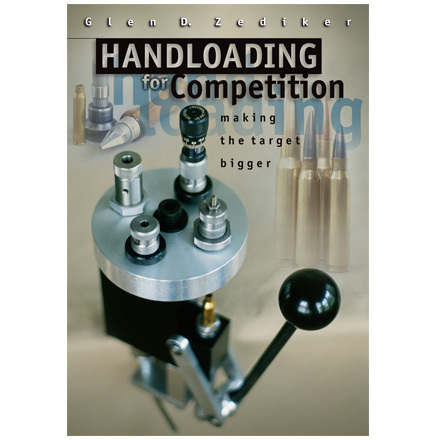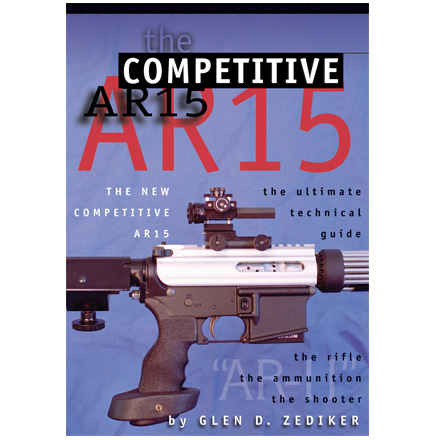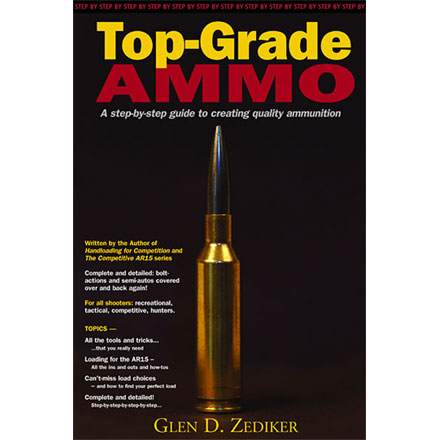|
|
September 20th, 2023

Close-up view of a sectioned case. This one here was “fixin’ to pop”, observed Glen Zediker.
|
Here are highlights from an article Glen Zediker wrote for the Midsouth Blog. In that article Glen, who sadly passed away in 2020, focused on cartridge brass. Glen identified the most common failures that appear with brass that has been shot multiple times, or which has been fired at excessive pressures. Glen explained some simple ways to check your cartridge brass to detect “early warning signs” of case failure, particularly case head separation, which can be very dangerous.
Glen authored many excellent books on reloading. This article is adapted from two of Glen’s books: Handloading For Competition and Top-Grade Ammo. |
|
How Cases Degrade with Multiple Firings By Glen Zediker
This article explains when, and then how, to check after the progress of changes commencing with the firing on a new case. It’s the “progress of degeneration,” in a way of looking at it because the concern is getting a handle on when enough change in the brass has come about to require attention. Or abandonment. As said then, for me that’s 4 firings. That, as said last time, is when I might see changes that need attention. Also as said, that figure didn’t come out of a hat, but from my own notes in running my competition NRA High Power Rifle loads. [Editor’s Note: With Lapua brass, using moderate loads, in bolt-action rifles, we typically get about 10 good (match-worthy) firings. But if you anneal your Lapua brass, and run modest pressures, Lapua brass can perform well for 20 or more load cycles.]
The areas most affected are the case neck and case head area. Case neck walls get thicker [but] the case head area body walls get thinner. Primer pockets get shallower and larger diameter.

This case shows a cracked neck AND a crack (separation) above the case head. Zediker says it is “rare to see one case with both of the most common failures. [This case] was attacked by an M14.”
Case Head — Causes of Separation and Cracking
When a case is under pressure during firing, the brass, like water, flows where it can, where it’s more free to move. Of course, the chamber steel limits the amount it can expand. The case shoulder blows fully forward and the case base is slammed back against the bolt face. There is, therefore and in effect, a tug on both ends — it gets stretched. The shoulder area is relatively free to expand to conform to the chamber, but the other end, the case head area, is not. Since that’s the area of the case with the thickest walls, it doesn’t expand “out” much at all. What it does is stretch. The “case head area,” as I refer to it here, is the portion of the case above the web, which is just above the taper that leads in to the extractor groove. The “area” extends approximately an eighth-inch up the case body.

Here’s a “pressure ring.” You’ll see this after firing, if you see it. And, if you see it, that case is done. The bright ring indicates excessive stretching, which indicates excessive thinning. If you see a ring circling the case, noticeable because it’s lighter color than the case body, and it’s in this area, I’d say that case is done. And that’s right where a “head separation” occurs. It can crack and also blow slap in two, and that’s the “separation” part of case head separation.

Photo courtesy GS Arizona.
This is a spot to keep close watch on as cases age. It is also the area that is more “protected” by sizing with less case shoulder set-back. That is, pretty much, where the freedom for the stretching movement in this area comes from (the case shoulder creates a gap). If you’re seeing a sign that a head separation [might happen with relatively few firings], chances are the shoulder set-back is excessive, and also… the load pressure level.
Bent Paper Clip Case-Wall Gauge

Editor: You can use a bent paper clip to detect potential case wall problems. Slide the paper clip inside your case to check for thin spots. GS Arizona explains: “This simple little tool (bent paper clip) will let you check the inside of cases before you reload them. The thin spot will be immediately apparent as you run the clip up the inside of the case. If you’re seeing a shiny line on the outside and the clip is really hitting a thin spot inside, it’s time to retire the case.” Photo by GS Arizona.
Monitor Primer Pocket Dimensional Changes
Another case-head-area and pressure-related check is the primer pocket. As said, the primer pocket will get larger in diameter and shallower in depth each firing. As with many such things, the questions are “when” and “how much,” and the main thing, “how much?”
If the pocket gets excessively shallow, and that’s judged by a primer that seats fully but isn’t at least a tick below flush with the case base, there could be function issues. There’s a risk of a “slam-fire” with a semi-auto that uses a floating firing pin, and, if there is actual protrusion, that has the same effect as insufficient headspace. A primer pocket uniformer can reset the depth of a shallowed primer pocket to what it should be, but the real test for me is how easily the next primer seats into it. If it’s significantly less resistance, I’ll say that case is done. Shallower can be refurbished. That’s a primary function of a primer pocket uniformer. Larger diameter, though, can’t be fixed. I’ve mentioned in another article or two that, any more at least, my main gauge of load pressure has become how much primer pocket expansion there’s been.
Share the post "Inspect Your Brass To Detect Case Failure Warning Signs"
March 29th, 2019

Close-up view of a sectioned case. This one here was “fixin’ to pop”, says Glen Zediker.
Here are highlights from an article Glen Zediker wrote for the Midsouth Blog. In this article Glen focuses on cartridge brass. Glen discusses the most common failures that appear with brass that has been shot multiple times, or which has been fired at excessive pressures. Glen explains some simple ways to check your cartridge brass to detect “early warning signs” of case failure, particularly case head separation, which can be dangerous.
Glen is the author of many excellent books on reloading. This article is adapted from Glen’s books, Handloading For Competition and Top-Grade Ammo, available at Midsouth HERE. For more information about other books by Glen, visit ZedikerPublishing.com.
How Cases Degrade with Multiple Firings By Glen Zediker
This article explains when, and then how, to check after the progress of changes commencing with the firing on a new case. It’s the “progress of degeneration,” in a way of looking at it because the concern is getting a handle on when enough change in the brass has come about to require attention. Or abandonment. As said then, for me that’s 4 firings. That, as said last time, is when I might see changes that need attention. Also as said, that figure didn’t come out of a hat, but from my own notes in running my competition NRA High Power Rifle loads. [Editor’s Note: With Lapua brass, using moderate loads, in bolt-action rifles, we typically get about 10 good (match-worthy) firings. But if you anneal your Lapua brass, and run modest pressures, Lapua brass can perform well for 20 or more load cycles.]
The areas most affected are the case neck and case head area. Case neck walls get thicker [but] the case head area body walls get thinner. Primer pockets get shallower and larger diameter.

This case shows a cracked neck AND a crack (separation) above the case head. Zediker says it is “rare to see one case with both of the most common failures. [This case] was attacked by an M14.”
Case Head — Causes of Separation and Cracking
When a case is under pressure during firing, the brass, like water, flows where it can, where it’s more free to move. Of course, the chamber steel limits the amount it can expand. The case shoulder blows fully forward and the case base is slammed back against the bolt face. There is, therefore and in effect, a tug on both ends — it gets stretched. The shoulder area is relatively free to expand to conform to the chamber, but the other end, the case head area, is not. Since that’s the area of the case with the thickest walls, it doesn’t expand “out” much at all. What it does is stretch. The “case head area,” as I refer to it here, is the portion of the case above the web, which is just above the taper that leads in to the extractor groove. The “area” extends approximately an eighth-inch up the case body.

Here’s a “pressure ring.” You’ll see this after firing, if you see it. And, if you see it, that case is done. The bright ring indicates excessive stretching, which indicates excessive thinning. If you see a ring circling the case, noticeable because it’s lighter color than the case body, and it’s in this area, I’d say that case is done. And that’s right where a “head separation” occurs. It can crack and also blow slap in two, and that’s the “separation” part of case head separation.

Photo courtesy GS Arizona.
This is a spot to keep close watch on as cases age. It is also the area that is more “protected” by sizing with less case shoulder set-back. That is, pretty much, where the freedom for the stretching movement in this area comes from (the case shoulder creates a gap). If you’re seeing a sign that a head separation [might happen with relatively few firings], chances are the shoulder set-back is excessive, and also… the load pressure level.
Bent Paper Clip Case-Wall Gauge

Editor: You can use a bent paper clip to detect potential case wall problems. Slide the paper clip inside your case to check for thin spots. GS Arizona explains: “This simple little tool (bent paper clip) will let you check the inside of cases before you reload them. The thin spot will be immediately apparent as you run the clip up the inside of the case. If you’re seeing a shiny line on the outside and the clip is really hitting a thin spot inside, it’s time to retire the case.” Photo by GS Arizona.
Monitor Primer Pocket Dimensional Changes
Another case-head-area and pressure-related check is the primer pocket. As said, the primer pocket will get larger in diameter and shallower in depth each firing. As with many such things, the questions are “when” and “how much,” and the main thing, “how much?”
If the pocket gets excessively shallow, and that’s judged by a primer that seats fully but isn’t at least a tick below flush with the case base, there could be function issues. There’s a risk of a “slam-fire” with a semi-auto that uses a floating firing pin, and, if there is actual protrusion, that has the same effect as insufficient headspace. A primer pocket uniformer can reset the depth of a shallowed primer pocket to what it should be, but the real test for me is how easily the next primer seats into it. If it’s significantly less resistance, I’ll say that case is done. Shallower can be refurbished. That’s a primary function of a primer pocket uniformer. Larger diameter, though, can’t be fixed. I’ve mentioned in another article or two that, any more at least, my main gauge of load pressure has become how much primer pocket expansion there’s been.
 Glen’s books, Handloading For Competition and Top-Grade Ammo, are available at Midsouth HERE. For more information about other books by Glen, visit ZedikerPublishing.com Glen’s books, Handloading For Competition and Top-Grade Ammo, are available at Midsouth HERE. For more information about other books by Glen, visit ZedikerPublishing.com
Glen’s newest book, America’s Gun: The Practical AR15. Check it out HERE!
Share the post "Inspect Your Fired Brass to Avoid Catastrophic Case Failures"
May 24th, 2018

 Here is interesting news, particularly for pistol shooters and PRS competitors. You can now get premium, induction-annealed cartridge brass from SIG Sauer, the noted maker of Swiss-designed pistols and rifles. SIG Sauer is now manufacturing pistol and rifle brass at its state-of-the-art ammunition facility in Jacksonville, Arkansas. Notably, all Elite Performance rifle shell cases are induction annealed for consistent neck tension and case longevity. SIG states this brass is “engineered to exacting tolerances” and “the geometric consistency … ensures each primer is held tightly in its pocket. Flash holes are precise with no burrs and the superior metallurgical properties of the SIG Sauer cases enable repeated reloading.” Here is interesting news, particularly for pistol shooters and PRS competitors. You can now get premium, induction-annealed cartridge brass from SIG Sauer, the noted maker of Swiss-designed pistols and rifles. SIG Sauer is now manufacturing pistol and rifle brass at its state-of-the-art ammunition facility in Jacksonville, Arkansas. Notably, all Elite Performance rifle shell cases are induction annealed for consistent neck tension and case longevity. SIG states this brass is “engineered to exacting tolerances” and “the geometric consistency … ensures each primer is held tightly in its pocket. Flash holes are precise with no burrs and the superior metallurgical properties of the SIG Sauer cases enable repeated reloading.”
Rifle Brass Pricing is Attractive
We haven’t tried SIG Sauer rifle brass yet, but we are tempted as pricing is competitive. For example, a 50-count bag of 6.5 Creedmoor brass costs $33.95 on SIG’s online store. Varminters take note — 50 22-250 brass cases cost $25.95, while a 100-ct bag of .223 Rem brass is $35.95 (just 36 cents each).
SIG rifle cases are available for these cartridge types: .223 Rem, 22-250 Rem, .243 Win, 6.5 Creedmoor, .300 BLK, .308 Win, .and 300 Win Mag. Coming soon are .270 Win and .30-06 Springfield brass. Cases for most rifle cartridge types are sold 50 to a bag (100 for .223 Rem).
SIG Pistol Brass Sold Both Primed and Unprimed
SIG’s pistol brass is offered either primed or unprimed, at affordable prices. For example, 100 .45 ACP cases cost $33.95 primed, or $27.95 unprimed. 9mm Luger is even cheaper — just $25.95 for primed cases, or $20.95 for 9mm unprimed. To save time, we’d be tempted to buy the primed cases.
SIG pistol cases are available, primed or unprimed, in 100-ct bags for the following cartridge types: .380 Auto, 9mm Luger (9x19mm), .357 SIG, .38 Special, .357 Magnum, 40 S&W, 10mm Auto, .45 ACP.

COMMENT: Honestly, we don’t see many Benchrest and F-Class competitors moving away from Lapua brass which is superb, and holds the vast majority of records in those disciplines. However, for other disciplines, such as 3-Gun and Tactical matches, where you may not be able to recover your brass, it makes sense to consider cheaper alternatives. Likewise, varminters, who may shoot hundreds of rounds in an outing, may favor less costly cartridge brass.
“Each brass case undergoes rigorous in-line and post production quality assurance testing to ensure a flawless casing”, said Brad Criner, SIG Sauer’s Senior Director of Brand Management and Business Development. “The result is unparalleled durability and dependability.” All SIG Sauer Elite Performance ammunition and components are manufactured at SIG’s new ammo plant in Jacksonville, Arkansas. For more information on SIG cartridge brass visit the SIG Sauer Brass Webpage.
Share the post "SIG Sauer Now Offers Component Rifle and Pistol Brass"
|

























 Glen’s books, Handloading For Competition and Top-Grade Ammo, are available at Midsouth
Glen’s books, Handloading For Competition and Top-Grade Ammo, are available at Midsouth 
 Here is interesting news, particularly for pistol shooters and PRS competitors. You can now get premium, induction-annealed cartridge brass from SIG Sauer, the noted maker of Swiss-designed pistols and rifles. SIG Sauer is now manufacturing pistol and rifle brass at its state-of-the-art ammunition facility in Jacksonville, Arkansas. Notably, all Elite Performance rifle shell cases are induction annealed for consistent neck tension and case longevity. SIG states this brass is “engineered to exacting tolerances” and “the geometric consistency … ensures each primer is held tightly in its pocket. Flash holes are precise with no burrs and the superior metallurgical properties of the SIG Sauer cases enable repeated reloading.”
Here is interesting news, particularly for pistol shooters and PRS competitors. You can now get premium, induction-annealed cartridge brass from SIG Sauer, the noted maker of Swiss-designed pistols and rifles. SIG Sauer is now manufacturing pistol and rifle brass at its state-of-the-art ammunition facility in Jacksonville, Arkansas. Notably, all Elite Performance rifle shell cases are induction annealed for consistent neck tension and case longevity. SIG states this brass is “engineered to exacting tolerances” and “the geometric consistency … ensures each primer is held tightly in its pocket. Flash holes are precise with no burrs and the superior metallurgical properties of the SIG Sauer cases enable repeated reloading.”





